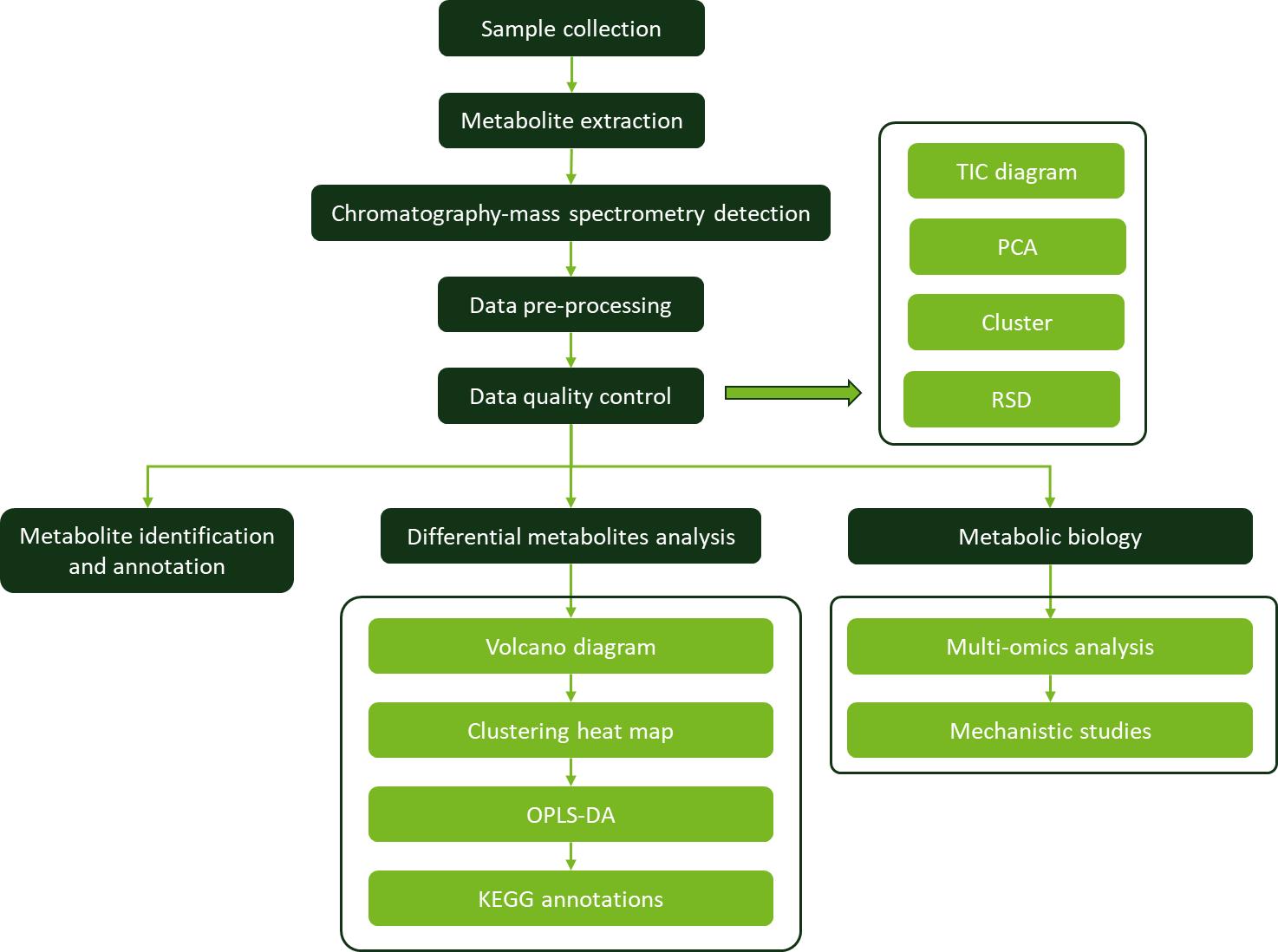What are Ether Compounds?
Ethers are organic compounds characterized by an oxygen atom bonded to two alkyl or aryl groups, with the general formula R−O−R′. Their unique structure gives them properties like low reactivity, volatility, and versatility, making them essential as solvents, intermediates, and active components in industries such as pharmaceuticals, petrochemicals, and environmental sciences. Common examples include diethyl ether, tetrahydrofuran (THF), and methyl tert-butyl ether (MTBE).
Metabolomics analysis of ether compounds is critical for understanding their roles in biological and industrial contexts. Biologically, certain ethers, such as glycerol ethers, are key to lipid metabolism and energy production. In environmental sciences, metabolomics helps monitor and assess the degradation and ecological impact of ethers like MTBE, often found as pollutants. For pharmaceuticals and chemicals, such analysis ensures product quality, regulatory compliance, and safety while aiding drug metabolism studies and process optimization.
Ether Compounds Analysis Offered by Creative Proteomics
Ether Compounds Qualitative and Quantitative Analysis: We identify and quantify ether compounds in complex samples, delivering actionable insights for biological research, environmental studies, and industrial applications.
Purity and Contaminant Assessment: Ensure your products meet industry standards with our comprehensive analysis of ether purity and impurity detection.
Metabolite Profiling: Analyze ether-derived metabolites in biological samples such as blood, urine, and tissue, essential for pharmaceutical and biomedical studies.
Tailored Solutions: We design customized workflows and provide expert consultation to meet unique project requirements.
 Workflow for Plant Metabolomics Service
Workflow for Plant Metabolomics Service
Platforms for Ethers Compounds Analysis
Gas Chromatography-Mass Spectrometry (GC-MS)
Model: Agilent 7890B GC System coupled with Agilent 5977B MSD
Application: Ideal for volatile and semi-volatile ether compounds.
Liquid Chromatography-Mass Spectrometry (LC-MS)
Model: Thermo Fisher Scientific Q Exactive HF Orbitrap
Application: Best suited for non-volatile and thermally unstable ethers.
High-Performance Liquid Chromatography (HPLC)
Model: Waters Alliance e2695 HPLC System
Application: Purity analysis and quantification of non-volatile ethers.
Nuclear Magnetic Resonance (NMR) Spectroscopy
Model: Bruker AVANCE III HD 500 MHz
Application: Comprehensive molecular structure analysis.
List of Ethers Compounds We Can Analyze
| Category |
Ketone Compounds |
| Aliphatic Ethers |
Diethyl ether, Methyl tert-butyl ether (MTBE), Ethyl tert-butyl ether (ETBE), Dimethyl ether |
| Aromatic Ethers |
Anisole, Diphenyl ether, Benzyl methyl ether, Phenyl ethyl ether |
| Cyclic Ethers |
Tetrahydrofuran (THF), 1,4-Dioxane, 1,3-Dioxolane, Epoxides (e.g., ethylene oxide, propylene oxide) |
| Polyethers |
Polyethylene glycol ethers (PEG ethers), Polypropylene glycol ethers, Crown ethers (e.g., 18-crown-6, 15-crown-5) |
| Functionalized Ethers |
Methoxyacetic acid, Ethylene glycol dimethyl ether (Diglyme), Ethylene glycol diethyl ether |
| Ethers with Halogens |
Halogenated ethers (e.g., Chloromethyl methyl ether, Bromomethyl ethyl ether) |
| Ethers with Sulfur |
Thioethers (e.g., Dimethyl sulfide, Diethyl sulfide) |
| Glycol Ethers |
Ethylene glycol monoethyl ether (Cellosolve), Propylene glycol methyl ether |
| Amino Ethers |
Aminoethyl ether, Methoxypropylamine |
| Industrial Ethers |
Solvents (e.g., Diisopropyl ether), Additives like TAME (Tertiary amyl methyl ether) |
Sample Requirements for Ethers Compounds Assay
| Sample Type |
Required Volume/Weight |
Storage Conditions |
Additional Notes |
| Biological Samples |
1-2 mL (liquid), 10-50 mg (solid) |
Store at -80°C |
Includes blood, urine, tissue. Provide information on species and collection method. |
| Environmental Samples |
100 mL (water), 10-50 g (soil) |
Store at 4°C or as specified |
Includes water, soil, and air particulates. Ensure no contamination during sampling. |
| Industrial Products |
5-10 mL (liquid), 10-50 mg (solid) |
Store in sealed, inert containers |
Includes solvents, chemical intermediates, and final products. Avoid exposure to air. |
| Volatile Ethers |
5-10 mL |
Store in airtight vials at -20°C |
Use gas-tight syringes for sampling. Prevent loss due to evaporation. |
| Custom Samples |
Case-by-case basis |
Consult with Creative Proteomics |
Provide detailed sample matrix and target compound information for guidance. |
Applications of Ethers Compounds Analysis
Pharmaceutical Research and Development: Ethers are commonly used in drug formulation and as intermediates in synthesis. Their analysis ensures drug safety, stability, and efficacy, aiding in pharmacokinetics studies and quality control.
Environmental Monitoring: Ethers like methyl tert-butyl ether (MTBE) are significant environmental contaminants. Their analysis helps monitor pollution levels, assess biodegradation pathways, and ensure compliance with environmental regulations.
Industrial Quality Control: In industries such as petrochemicals and solvents manufacturing, ether analysis ensures product purity and detects impurities or by-products, helping maintain production standards.
Biomedical and Metabolomics Research: Naturally occurring ethers, such as glycerol ethers, play essential roles in lipid metabolism and cellular signaling. Their profiling supports studies on metabolic disorders and biological functions.
Deliverables
- Comprehensive Data: Raw and processed data files.
- Analytical Results: Tables, graphs, and spectra illustrating compound identification and quantification.
- Interpretative Insights: Expert commentary on the findings.
- Methodology Description: Detailed explanation of analytical techniques employed.
- Quality Assurance: Documentation of quality control measures.
Title: Unequivocal Mapping of Molecular Ether Lipid Species by LC–MS/MS in Plasmalogen-Deficient Mice
Journal: Analytical Chemistry
Published: 2020
Background
Ether lipids, which include plasmalogens, are critical components of cellular membranes and are involved in antioxidant activity and signal transduction. These lipids are characterized by their unique chemical structures, such as ether-linked fatty alcohols at the sn-1 position. Plasmalogens possess a vinyl ether bond that gives them distinct physical and chemical properties. Deficiency in ether lipid biosynthesis, as seen in rhizomelic chondrodysplasia punctata and other peroxisomal disorders, leads to severe clinical manifestations. However, the specific roles of plasmanyl (1-O-alkyl) and plasmenyl (1-O-alk-1'-enyl) ether lipids in pathology remain unclear.
Lipidomic analysis of these ether lipids has been challenging due to the inability of existing methods to distinguish between isobaric lipid species. This study aims to develop a robust LC–MS/MS method to differentiate plasmanyl and plasmenyl ether lipids, validated in a novel plasmalogen-deficient mouse model lacking plasmanylethanolamine desaturase (PEDS), encoded by TMEM189.
Materials & Methods
Breeding and Sample Preparation
- Mouse Model: Peds1-deficient mice bred per approved protocols.
- Tissue Collection: Mouse tissues were harvested for lipidomic analysis.
- Sample Extraction: Lipid extraction and preparation followed standard protocols (referenced).
LC–MS/MS Analysis
- Parameters: Analysis of phosphatidylethanolamine (PE) and phosphatidylcholine (PC) lipids adapted from previous methodologies.
- Differentiation: Used chromatographic retention properties and unique fragmentation patterns to distinguish plasmanyl from plasmenyl species.
Data Analysis
- Tools: Data visualized in MZmine 2; processed using an in-house R pipeline.
- Normalization: Lipid concentrations normalized to total class response per sample.
- Statistical Methods: Principal component analysis (PCA) and quadratic regression for semiquantitative transformation of peak areas.
Standards and Validation
- Standards: Lipid standards purchased from Avanti Polar Lipids.
- Manual Curation: Peaks validated through retention time, mass-to-charge ratio (m/z), fragmentation data, and technical replicates.
Results
Discrimination Between Plasmanyl and Plasmenyl Lipids
- A reliable LC–MS/MS strategy was developed to distinguish between plasmanyl (1-O-alkyl) and plasmenyl (1-O-alk-1′-enyl) ether lipids.
- Predictable chromatographic behaviors were utilized, including retention time differences and m/z characteristics, to overcome analytical challenges posed by the isomeric nature of these lipids.
Validation Using ΔPeds1 Mice
- Tissue samples from Peds1-deficient (ΔPeds1) mice, which accumulate plasmanyl lipids due to a lack of plasmalogens, were used to validate the method.
- In wild-type (wt) kidney samples, plasmenyl-PE and plasmenyl-PC species were abundant, while these were replaced by plasmanyl-PE and plasmanyl-PC species in ΔPeds1 kidneys.
Retention Time Characteristics
- Retention time differences between alkyl and alk-1′-enyl species were consistently observed across PE and PC lipid classes, with alk-1′-enyl lipids eluting earlier.
- Systematic analysis revealed that vinyl ether double bonds caused smaller retention time shifts compared to acyl chain double bonds or chain elongation.
Fragmentation Patterns
- Negative ESI mode fragmentation patterns of isomeric lipids showed that sn-2 acyl chains are predominantly fragmented, providing insight into the structural differences between alkyl and alk-1′-enyl species.
- This method enabled reliable identification and annotation of ether lipids across multiple tissues.
Quantitative Differences in Lipid Composition
- Quantitative depletion of plasmenyl lipids and accumulation of plasmanyl lipids were observed in ΔPeds1 tissues across all tested organs.
- Wild-type tissues showed significant diversity and tissue-specific distribution of ether lipid species, particularly in cerebrum, cerebellum, and kidneys.
Sex- and Tissue-Specific Variations
- Male and female lipid profiles exhibited differences in certain fatty acyl compositions (e.g., FA 20:4 and FA 22:6), especially in kidneys.
- The cerebrum and cerebellum contained the highest levels of ether lipids, while the liver showed minimal ether lipid content.
Principal Component Analysis (PCA)
- PCA distinguished ΔPeds1 from wt tissues and highlighted gender-specific differences in lipid profiles.
- Tissue-specific lipid profiles showed consistent patterns of ether lipid distribution.
Broader Implications
- The method facilitates comprehensive annotation and quantification of ether lipids, advancing the field of lipidomics and enabling further investigation of their physiological roles.
- The study highlights the importance of ether lipids in maintaining phospholipid mass and provides a basis for exploring their involvement in disorders such as neurodegenerative diseases.
 Annotation of plasmanyl and plasmenyl lipids by means of HPLC–MS/MS
Annotation of plasmanyl and plasmenyl lipids by means of HPLC–MS/MS
 Discrimination between 1-O-alkyl and 1-O-alk-1′-enyl lipids by LC–MS/MS
Discrimination between 1-O-alkyl and 1-O-alk-1′-enyl lipids by LC–MS/MS
Reference
- Koch, Jakob, et al. "Unequivocal mapping of molecular ether lipid species by LC–MS/MS in plasmalogen-deficient mice." Analytical chemistry 92.16 (2020): 11268-11276.


 Workflow for Plant Metabolomics Service
Workflow for Plant Metabolomics Service Annotation of plasmanyl and plasmenyl lipids by means of HPLC–MS/MS
Annotation of plasmanyl and plasmenyl lipids by means of HPLC–MS/MS Discrimination between 1-O-alkyl and 1-O-alk-1′-enyl lipids by LC–MS/MS
Discrimination between 1-O-alkyl and 1-O-alk-1′-enyl lipids by LC–MS/MS

